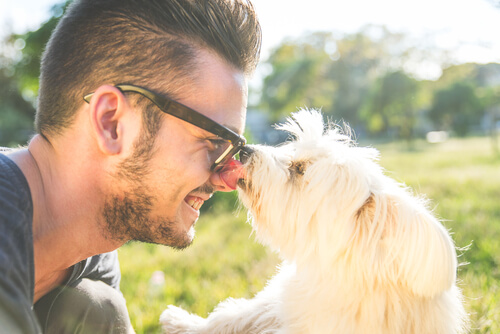How to Prevent Velcro Dog Syndrome

After a while, many people realize that their pet is very clingy, often called “Velcro dog syndrome.” It’s true that a dog should have a certain level of dependence on us, as we allow him to eat, drink and stay clean.
Nevertheless, when this dependence goes to the extreme, it benefits no one. What can you do for Velcro dog syndrome?
What is Velcro dog syndrome?
Dogs that suffer from Velcro dog syndrome are those that need to be near their owners at all times in order to be happy and confident. Otherwise, they can’t cope. This is not a behavior that a dog is born with, but rather is developed over time. It’s usually due in large part to the owners, although there are other factors that play a part, such as:

- Early weaning.
- Stress of the dog’s mother during gestation.
- Not having self-management tools for his upbringing and training.
- Excessive stimulation during the puppy phase.
However, we shouldn’t confuse separation anxiety with Velcro dog syndrome. Separation anxiety is something that normally happens with puppies. However, it should go away once you establish trust with your dog. Separation anxiety is also something specific that later goes away while you leave the animal alone.
Nevertheless, Velcro dog syndrome is more extreme, meaning that a dog can’t be happy any time the owners aren’t with him.
How to influence the dog’s clinginess
Velcro dog syndrome leads the animal to experience a lack of joy, as he is only satisfied when he is with his owners. Additionally, it can bring a lot of stress, which could lead to serious health problems, as he could stop eating or become depressed.
According to a famous professional dog trainer, “having high levels of stress leads to metabolic waste, just as in people. This clinginess causes the dog to age more quickly, and its quality of life in this advanced age is much worse.”
There are those that believe that certain dog breeds are more prone to being “Velcro dogs” than others, but this isn’t proven. Dog breeds aren’t born clingy, rather as we’ve already mentioned, they become clingy through different factors, especially their training. What can be done, then, to avoid raising a “Velcro dog”?
How to avoid raising a “Velcro dog”
There are various things that we can do as far as raising a dog so that he doesn’t become a clingy, “Velcro dog.” Here are a few:

- Does your dog has a tendency to follow you? Maybe because it’s what you’ve taught him to do since he was a puppy. This must stop. When you get home and after you’ve greeted each other spend some time alone. Teach him two or three words. These will help him understand that he should go to his bed or his spot.
- Be firm and consistent. If you decide that he should go to his own spot after greeting, make this a habit. Do it always. Don’t let it be once and done. After all, this won’t help him understand. And as a result, he will still be clingy.
- Be affectionate. Just because we don’t want our dog to have Velcro dog syndrome doesn’t mean that we should start ignoring him. We simply need to find the balance between allowing him to be clingy and snuggling with him every so often.
- Don’t humanize him. A dog is and always will be a dog. Give him his spot but don’t humanize him. If you do, the animal will be too clingy and won’t be able to be happy without you there.
Source of the first image: freestocks.org
This text is provided for informational purposes only and does not replace consultation with a professional. If in doubt, consult your specialist.